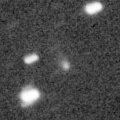
|
It was visible at 7-8 mag between Apr. 7 and 9 in the SWAN images. It was expected to brighten up to 4 mag, but it faded rapidly around the perihelion passage. In the Southern Hemisphere, it was observable in the extremely low sky in mid April. But it was not visible, fainter than 7.6 mag (Apr. 19, Chris Wyatt). It was not detected by photo, fainter than 9.0 mag (Apr. 21, Michael Mattiazzo). In the Northern Hemisphere, it is appearing in the evening sky. Now it is 9.9 mag (May 2, Mike Olason). It stays observable in good condition after this while the comet will be fading. In the Southern Hemisphere, it is not observable until August.
Date(TT) R.A. (2000) Decl. Delta r Elong. m1 Best Time(A, h)
Apr. 30 3 30.00 21 0.6 0.682 0.400 16 9.2 20:17 (119, -2)
May 7 3 52.61 41 41.0 0.604 0.553 27 10.3 20:25 (137, 9)
|

|
It was very bright as 6.8 mag between Apr. 21 27 in the SOHO LASCO images (Hirohisa Sato). It has not been observed yet on the ground. The condition is very bad in this apparition. It is observable only in the extremely low sky from mid May to mid July in the Northern Hemisphere, or from early June to early August in the Southern Hemisphere.
Date(TT) R.A. (2000) Decl. Delta r Elong. m1 Best Time(A, h)
Apr. 30 3 11.43 17 18.3 1.521 0.565 10 9.2 20:17 (118, -8)
May 7 4 1.13 20 42.5 1.504 0.605 16 9.6 20:25 (119, -3)
|
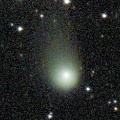
|
Now it is bright as 10.1 mag (Apr. 30, Marco Goiato). The brightness evolution is slower than originally expected. It is expected to be observable at 7 mag for a long time from 2022 to 2023. In the Northern Hemisphere, it stays observable in good condition until autumn. However, it is not observable at the high light from autumn to 2023 summer. In the Southern Hemisphere, it stays observable in good condition for a long time.
Date(TT) R.A. (2000) Decl. Delta r Elong. m1 Best Time(A, h)
Apr. 30 18 51.55 11 44.1 2.844 3.320 109 9.7 3:37 (334, 65)
May 7 18 47.86 11 34.2 2.688 3.257 115 9.5 3:28 (346, 66)
|
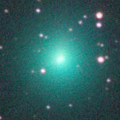
|
It brightened very rapidly up to 9.3 mag in March (Mar. 24, Michael Jager). Now it is not observable. In the Southern Hemisphere, it will appear in the morning sky in late May. Then it stays observable in good condition after that. In the Northern Hemisphere, it will never be observable again.
Date(TT) R.A. (2000) Decl. Delta r Elong. m1 Best Time(A, h)
Apr. 30 1 55.78 13 5.2 2.060 1.071 7 10.2 3:37 (243,-13)
May 7 2 8.45 9 49.4 2.078 1.120 13 10.6 3:28 (246,-14)
|

|
Now it is 10.3 mag (May 2, Chris Wyatt). It will be getting lower after this. In the Northern Hemisphere, it will be unobservable in May. In the Southern Hemisphere, it stays observable until July.
Date(TT) R.A. (2000) Decl. Delta r Elong. m1 Best Time(A, h)
Apr. 30 7 2.73 12 56.5 3.978 3.694 66 10.4 20:17 ( 81, 35)
May 7 7 8.76 12 5.1 4.086 3.711 61 10.5 20:25 ( 85, 28)
|

|
Now it is 11.2 mag (Apr. 17, Thomas Lehmann). In the Northern Hemisphere, it stays extremely low until spring. In the Southern Hemisphere, it stays observable at 11 mag until June.
Date(TT) R.A. (2000) Decl. Delta r Elong. m1 Best Time(A, h)
Apr. 30 22 54.84 -7 39.1 1.916 1.613 57 11.1 3:37 (287, 10)
May 7 23 12.15 -6 10.8 1.893 1.633 59 11.2 3:28 (286, 11)
|
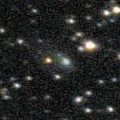
|
Now it is very bright as 11.4 mag (Apr. 30, Marco Goiato). It will brighten up to 10-11 mag from spring to summer. In the Southen Hemisphere, it stays observable in good condition for a long time after this. In the Northern Hemisphere, it is hardly observable after this.
Date(TT) R.A. (2000) Decl. Delta r Elong. m1 Best Time(A, h)
Apr. 30 21 29.71 -42 59.4 1.582 1.861 89 11.7 3:37 (325, 0)
May 7 21 43.72 -49 25.8 1.451 1.837 94 11.4 3:28 (330, -5)
|

|
Now it is bright as 11.2 mag (Apr. 29, Carlos Labordena). It stays observable at 11-12 mag until July.
Date(TT) R.A. (2000) Decl. Delta r Elong. m1 Best Time(A, h)
Apr. 30 11 44.23 -14 51.5 3.430 4.256 140 11.5 21:11 ( 0, 40)
May 7 11 43.98 -13 20.1 3.489 4.251 133 11.5 20:43 ( 0, 42)
|
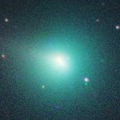
|
Now it is bright as 10.9 mag (Apr. 30, Osamu Miyazaki). It will be fading after this. But it may stay brighter than this ephemeris for a while. In the Northern Hemisphere, it stays observable in excellent condition for a long time. In the Southern Hemisphere, it stays extremely low after this.
Date(TT) R.A. (2000) Decl. Delta r Elong. m1 Best Time(A, h)
Apr. 30 6 13.35 42 36.6 1.996 1.652 55 12.2 20:17 (120, 38)
May 7 6 40.01 42 59.4 2.078 1.699 54 12.4 20:25 (121, 36)
|

|
Now it is bright as 12.9 mag (Apr. 21, Michael Jager). It is expected to brighten up to 9-10 mag in summer. In the Northern Hemisphere, it stays observable in good condition until June when it brightens up to 10 mag. But it is not observable after the high light. In the Souther Hemisphere, it is not observable until October.
Date(TT) R.A. (2000) Decl. Delta r Elong. m1 Best Time(A, h)
Apr. 30 3 24.54 59 21.6 2.337 1.790 45 12.6 20:17 (149, 20)
May 7 4 1.89 59 23.0 2.278 1.711 44 12.3 20:25 (149, 21)
|

|
Now it is 13.4 mag (Apr. 17, Thomas Lehmann). It stays 12-13 mag for a while. It is observable in excellent condition in the Southern Hemisphere. It locates low until May in the Northern Hemisphere.
Date(TT) R.A. (2000) Decl. Delta r Elong. m1 Best Time(A, h)
Apr. 30 21 34.59 -21 8.7 1.473 1.639 80 12.5 3:37 (311, 16)
May 7 21 50.65 -20 47.0 1.442 1.662 83 12.5 3:28 (311, 16)
|
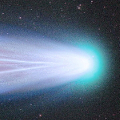
|
It brightened up to 3 mag from mid December to late December. Now it is fading. It has already faded down to 12.2 mag (Apr. 2, Thomas Lehmann). It is observable in good condition in the Southern Hemisphere. It is getting observable again also in the Northern Hemisphere.
Date(TT) R.A. (2000) Decl. Delta r Elong. m1 Best Time(A, h)
Apr. 30 20 12.62 -38 0.6 1.734 2.177 101 13.1 3:37 (335, 11)
May 7 19 52.56 -38 38.0 1.691 2.274 112 13.2 3:28 (342, 14)
|

|
Now it is 14.8 mag (May 2, Chris Wyatt). It was expected to brighten up to 13 mag in spring. But actually, it is fainter than this ephemeris recently. In the Southern Hemisphere, it stays observable in good condition for a long time. In the Northern Hemisphere, it is not observable until autumn.
Date(TT) R.A. (2000) Decl. Delta r Elong. m1 Best Time(A, h)
Apr. 30 6 32.35 -51 37.0 3.098 3.168 84 13.5 20:17 ( 35,-13)
May 7 6 29.96 -49 21.6 3.149 3.158 81 13.5 20:25 ( 41,-17)
|

|
Now it is 15.5 mag (Apr. 5, Slooh.com Chile Observatory). It will brighten up to 12.5 mag in summer. In the Southern Hemisphere, it stays observable in excellent condition for a long time. In the Northern Hemisphere, it is not observable until August.
Date(TT) R.A. (2000) Decl. Delta r Elong. m1 Best Time(A, h)
Apr. 30 22 46.41 -55 22.3 3.211 3.263 83 13.7 3:37 (326,-18)
May 7 22 42.79 -56 11.6 3.077 3.234 89 13.5 3:28 (328,-16)
|

|
Now it is 14.1 mag (Apr. 14, iTelescope Observatory, Siding Spring). It will brighten up to 13 mag in summer.
Date(TT) R.A. (2000) Decl. Delta r Elong. m1 Best Time(A, h)
Apr. 30 19 6.30 -27 41.7 2.500 3.059 114 13.7 3:37 (346, 26)
May 7 19 8.62 -28 3.4 2.413 3.055 120 13.6 3:28 (349, 26)
|
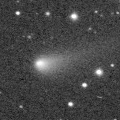
|
Now it is 13.7 mag (May 2, Chris Wyatt). It is observable at 13 mag in good condition until early summer.
Date(TT) R.A. (2000) Decl. Delta r Elong. m1 Best Time(A, h)
Apr. 30 9 38.70 16 41.7 1.827 2.264 102 13.7 20:17 ( 45, 66)
May 7 9 45.21 15 53.5 1.894 2.253 97 13.7 20:25 ( 56, 61)
|
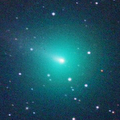
|
It brightened very rapidly up to 9.2 mag in winter (Jan. 31, Chris Wyatt). Now it is fading. But it is still bright as 12.6 mag (Apr. 5, Chris Wyatt). It will be fainter than 18 mag in July.
Date(TT) R.A. (2000) Decl. Delta r Elong. m1 Best Time(A, h)
Apr. 30 8 27.76 14 9.0 1.465 1.726 86 13.7 20:17 ( 65, 52)
May 7 8 45.86 13 27.5 1.580 1.786 84 14.2 20:25 ( 69, 48)
|
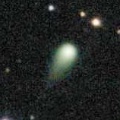
|
Now it is 13.4 mag (Apr. 21, Michael Jager). It is expected to brighten up to 10 mag in 2023. In the Northern Hemisphere, it stays observable in good condition until 2023 autumn. In the Southern Hemipshere, it stays unobservable until 2023 summer.
Date(TT) R.A. (2000) Decl. Delta r Elong. m1 Best Time(A, h)
Apr. 30 10 30.06 61 7.8 4.401 4.531 90 13.8 20:17 (174, 64)
May 7 10 19.74 60 40.5 4.440 4.474 85 13.7 20:25 (162, 62)
|
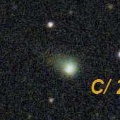
|
Now it is 13.9 mag (Apr. 21, Michael Jager). It is expected to brighten up to 12 mag in 2023. In the Northern Hemisphere, it stays observable in good condition for a long time. In the Southern Hemisphere, it locates extremely low in 2022, but it will be observable in good condition in 2023.
Date(TT) R.A. (2000) Decl. Delta r Elong. m1 Best Time(A, h)
Apr. 30 15 27.13 43 37.5 4.082 4.671 120 13.9 0:58 (180, 81)
May 7 15 13.60 43 44.6 4.053 4.633 119 13.9 0:17 (180, 81)
|

|
Now it is 16.7 mag (Apr. 30, Jean-Francois Soulier). In the Southern Hemisphere, it is already not observable. It will be unobservable soon also in the Northern Hemisphere.
Date(TT) R.A. (2000) Decl. Delta r Elong. m1 Best Time(A, h)
Apr. 30 4 56.81 29 5.7 6.751 5.981 37 14.0 20:17 (114, 18)
May 7 5 2.52 29 7.3 6.816 5.983 31 14.0 20:25 (117, 12)
|
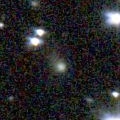
|
Now it is 14.6 mag (Apr. 10, Michael Jager). It is expected to brighten up to 11 mag in 2023. In the Northern Hemisphere, it stays observable in good condition until November. But it becomes unobservable after that. In the Southern Hemisphere, it stays observable in good condition after this.
Date(TT) R.A. (2000) Decl. Delta r Elong. m1 Best Time(A, h)
Apr. 30 18 59.45 18 55.0 4.300 4.667 105 14.2 3:37 (321, 70)
May 7 18 56.66 18 59.4 4.168 4.621 110 14.1 3:28 (335, 73)
|

|
It approaches to Sun down to 0.14 a.u. on May 15. But it is not observable around that time. In the Northern Hemisphere, it will appear in the morning sky at 16 mag in June. It is hardly observable in the Southern Hemisphere.
Date(TT) R.A. (2000) Decl. Delta r Elong. m1 Best Time(A, h)
Apr. 30 3 52.86 17 28.9 1.331 0.526 20 15.2 20:17 (112, -1)
May 7 4 4.33 16 44.7 1.143 0.339 16 14.4 20:25 (115, -6)
|
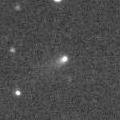
|
Now it is 16.1 mag (Apr. 28, Hirohisa Sato). It is expected to brighten up to 11 mag from summer to autumn. However, it is fainter than this ephemeris recently. It stays observable in good condition in the Southern Hemisphere. In the Northern Hemisphere, it becomes extremely low from August to September.
Date(TT) R.A. (2000) Decl. Delta r Elong. m1 Best Time(A, h)
Apr. 30 9 39.81 29 25.7 1.363 1.802 97 14.6 20:17 ( 74, 74)
May 7 9 42.60 28 19.5 1.377 1.738 92 14.4 20:25 ( 80, 67)
|

|
Now it is 14.8 mag (Apr. 15, iTelescope Observatory, Siding Spring). It stays at 15-16 mag for a long time. In the Southern Hemisphere, it stays observable in excellent condition for a long time. In the Northern Hemiphere, it locates extremely low in spring.
Date(TT) R.A. (2000) Decl. Delta r Elong. m1 Best Time(A, h)
Apr. 30 16 40.01 -47 23.6 4.391 5.176 137 14.9 2:11 ( 0, 8)
May 7 16 29.22 -48 23.0 4.351 5.191 142 14.8 1:33 ( 0, 7)
|
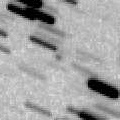
|
It is expected to brighten up to 13.5 mag in early summer. In the Southern Hemisphere, it will appear in the morning sky in May. Then it stays observable in good condition after that. In the Northern Hemisphere, it is not observable at all.
Date(TT) R.A. (2000) Decl. Delta r Elong. m1 Best Time(A, h)
Apr. 30 2 17.44 -11 50.3 2.207 1.382 26 15.1 3:37 (261,-33)
May 7 2 27.57 -14 3.3 2.093 1.340 31 14.9 3:28 (264,-33)
|

|
It brightened up to 12.3 mag from spring to summer in 2021 (June 15, 2021, Marco Goiato). Now it is fading. It has already faded down to 15.0 mag (Apr. 28, W. Pei).
Date(TT) R.A. (2000) Decl. Delta r Elong. m1 Best Time(A, h)
Apr. 30 12 41.79 30 42.7 4.097 4.784 128 15.0 22:08 ( 0, 86)
May 7 12 33.41 31 15.4 4.225 4.826 121 15.1 21:32 ( 0, 86)
|
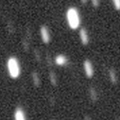
|
Now it is 15.4 mag (Apr. 24, Ken-ichi Kadota). It will approach to Earth down to 0.29 a.u. in 2023 February, and it is expected to brighten up to 5 mag. In the Northern Hemisphere, it stays observable in excellent condition. In the Southern Hemisphere, it becomes unobservable from late September to early February.
Date(TT) R.A. (2000) Decl. Delta r Elong. m1 Best Time(A, h)
Apr. 30 20 13.74 13 3.2 3.523 3.665 90 15.4 3:37 (300, 54)
May 7 20 12.03 14 54.6 3.349 3.591 95 15.2 3:28 (303, 59)
|

|
It brightened up to 8.5 mag from autumn to winter (Dec. 2, Toshihiko Ikemura, Hirohisa Sato). Now it is fading. It has already faded down to 13.7 mag (Apr. 5, Chris Wyatt). It stays observable in good condition for a long time.
Date(TT) R.A. (2000) Decl. Delta r Elong. m1 Best Time(A, h)
Apr. 30 9 15.12 19 50.7 1.988 2.317 95 15.2 20:17 ( 60, 64)
May 7 9 23.77 18 56.7 2.124 2.371 91 15.5 20:25 ( 67, 59)
|
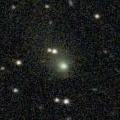
|
It became brighter after the perihelion passage, and it brightened up to 13.4 mag in early 2022 (Jan. 7, Hiroshi Abe). Now it is fading. It has already faded down to 15.4 mag (May 2, Chris Wyatt). It will be fainter than 18 mag in summer.
Date(TT) R.A. (2000) Decl. Delta r Elong. m1 Best Time(A, h)
Apr. 30 10 36.49 4 59.0 3.282 3.877 119 15.7 20:17 ( 7, 60)
May 7 10 31.66 4 13.3 3.430 3.919 111 15.9 20:25 ( 25, 57)
|
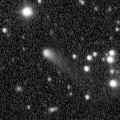
|
Now it is 15.7 mag (Apr. 19, Masayoshi Yoshimi). It stays observable at 16 mag from 2021 to 2022.
Date(TT) R.A. (2000) Decl. Delta r Elong. m1 Best Time(A, h)
Apr. 30 16 7.40 37 26.3 4.369 4.989 122 15.8 1:37 (180, 88)
May 7 16 2.94 38 47.9 4.395 5.007 122 15.9 1:05 (180, 86)
|

|
Now it is 16.5 mag (Apr. 10, ATLAS Chile, Rio Hurtado). It continued brightening even after the perihelion passage. Now it is fading. It will be fainter than 18 mag in July.
Date(TT) R.A. (2000) Decl. Delta r Elong. m1 Best Time(A, h)
Apr. 30 10 36.76 4 20.9 1.926 2.578 119 15.9 20:17 ( 6, 59)
May 7 10 42.91 5 50.9 2.033 2.610 113 16.1 20:25 ( 21, 59)
|

|
Now it is 16.5 mag (Apr. 13, ATLAS-HKO, Haleakala). It will brighten up to 11.5 mag in 2022 winter. It stays observable while the comet will be brightening slowly.
Date(TT) R.A. (2000) Decl. Delta r Elong. m1 Best Time(A, h)
Apr. 30 4 36.31 20 1.4 3.409 2.600 31 16.1 20:17 (108, 9)
May 7 4 48.16 20 28.3 3.415 2.558 27 15.9 20:25 (112, 5)
|

|
Now it is 17.8 mag (Apr. 21, J.-C. Merlin). It was expected to be observable at 16 mag in good condition in spring. But actually, it is fainter than predicted by 2-3 mag.
Date(TT) R.A. (2000) Decl. Delta r Elong. m1 Best Time(A, h)
Apr. 30 20 33.70 -16 4.6 1.031 1.474 92 16.1 3:37 (320, 28)
May 7 20 46.53 -13 5.3 1.008 1.494 95 16.1 3:28 (319, 31)
|

|
Now it is 17.5 mag (Apr. 24, Ken-ichi Kadota). It will brighten up to 16 mag from spring to summer. It locates somewhat low in the Northern Hemisphere.
Date(TT) R.A. (2000) Decl. Delta r Elong. m1 Best Time(A, h)
Apr. 30 19 51.15 -22 7.4 2.753 3.148 103 16.5 3:37 (333, 28)
May 7 19 54.75 -22 17.3 2.668 3.155 109 16.4 3:28 (336, 29)
|

|
It brightened up to 9.5 mag in early summer in 2021 (June 27, Marco Goiato). Now it is fading. It has already faded down to 18.2 mag (Apr. 18, E. Cortes). In the Northern Hemisphere, it is not observable until June.
Date(TT) R.A. (2000) Decl. Delta r Elong. m1 Best Time(A, h)
Apr. 30 22 49.67 -30 52.4 4.083 3.845 69 16.5 3:37 (306, -3)
May 7 22 56.38 -31 4.6 4.051 3.904 74 16.6 3:28 (307, -2)
|

|
Now it is 16.5 mag (Apr. 24, Ken-ichi Kadota). It was observed at 15 mag in 2021. Now it is fading. It stays observable at 16-17 mag for a while in 2022.
Date(TT) R.A. (2000) Decl. Delta r Elong. m1 Best Time(A, h)
Apr. 30 18 45.98 19 10.7 4.818 5.219 108 16.6 3:37 (329, 72)
May 7 18 44.19 20 42.9 4.770 5.239 112 16.6 3:28 (343, 75)
|

|
It brightened up to 14 mag in 2021. Now it is fading. Appearing in the morning sky. It is observable at 16-17 mag in 2022.
Date(TT) R.A. (2000) Decl. Delta r Elong. m1 Best Time(A, h)
Apr. 30 23 55.29 2 48.6 6.157 5.417 39 16.6 3:37 (269, 4)
May 7 23 58.78 3 45.5 6.116 5.450 45 16.6 3:28 (271, 8)
|

|
It brightened up to 14 mag from 2020 to 2021. Now it is fading slowly. It is observable at 16.5-17 mag in 2022.
Date(TT) R.A. (2000) Decl. Delta r Elong. m1 Best Time(A, h)
Apr. 30 23 51.05 -15 45.2 4.162 3.586 49 16.6 3:37 (285, -6)
May 7 23 58.74 -15 15.1 4.105 3.604 53 16.6 3:28 (286, -3)
|

|
It brightened up to 14.2 mag in 2021 summer (July 18, 2021, Taras Prystavski). Now it is fading. It has already faded down to 16.2 mag (Jan. 27, SONEAR Observatory, Oliveira). In the Southern Hemisphere, it stays observable in good condition for a long time, although it became extremely low temporarily from March to April. In the Northern Hemisphere, it is not observable until July.
Date(TT) R.A. (2000) Decl. Delta r Elong. m1 Best Time(A, h)
Apr. 30 1 30.03 -29 9.0 5.179 4.536 45 16.7 3:37 (285,-32)
May 7 1 36.42 -28 21.1 5.173 4.573 48 16.7 3:28 (286,-29)
|
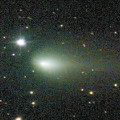
|
It brightened up to 10.6 mag in autumn (Oct. 10, Osamu Miyazaki). Now it is fading. It has already faded down to 16.0 mag (Apr. 18, Catalina Sky Survey). It stays observable in good condition for a long time.
Date(TT) R.A. (2000) Decl. Delta r Elong. m1 Best Time(A, h)
Apr. 30 7 38.75 14 50.1 2.774 2.691 74 16.7 20:17 ( 77, 43)
May 7 7 48.51 14 43.2 2.903 2.734 70 17.0 20:25 ( 81, 38)
|
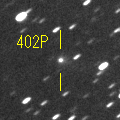
|
First return of a new periodic comet observed at 16 mag from 2003 to 2004. Now it is 16.7 mag (Apr. 22, Ken-ichi Kadota). It will be unobservable in June. But it will become observable again at 17 mag from autum to winter.
Date(TT) R.A. (2000) Decl. Delta r Elong. m1 Best Time(A, h)
Apr. 30 6 38.90 17 9.4 4.419 4.014 60 16.8 20:17 ( 89, 32)
May 7 6 45.81 17 36.6 4.515 4.022 55 16.8 20:25 ( 94, 26)
|
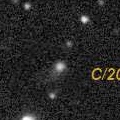
|
Now it is 16.8 mag (Apr. 28, J.-G. Bosch). It stays observable at 17-18 mag for a long time until 2024.
Date(TT) R.A. (2000) Decl. Delta r Elong. m1 Best Time(A, h)
Apr. 30 13 53.47 2 1.6 7.868 8.828 161 16.9 23:20 ( 0, 57)
May 7 13 48.89 2 29.9 7.902 8.826 154 16.9 22:48 ( 0, 57)
|

|
It brightened up to 13.9 mag in 2021 (Aug. 28, 2021, Toshihiko Ikemura, Hirohisa Sato). Now it is fading. It has already faded down to 17.4 mag (Apr. 4, Yasukazu Ikari). It will be fainter than 18 mag in June.
Date(TT) R.A. (2000) Decl. Delta r Elong. m1 Best Time(A, h)
Apr. 30 12 1.99 43 4.3 2.713 3.247 113 16.9 21:28 (180, 82)
May 7 11 46.40 41 35.2 2.852 3.297 107 17.2 20:45 (180, 84)
|

|
Now it is 16.1 mag (Apr. 9, Thomas Lehmann). It will be fading after this, and it will be fainter than 18 mag in June.
Date(TT) R.A. (2000) Decl. Delta r Elong. m1 Best Time(A, h)
Apr. 30 11 23.10 13 24.3 1.709 2.445 126 17.0 20:50 ( 0, 68)
May 7 11 25.20 12 54.7 1.806 2.474 120 17.1 20:25 ( 0, 68)
|

|
Now it is 16.7 mag (Apr. 21, Michael Jager). It stays 17 mag for a while.
Date(TT) R.A. (2000) Decl. Delta r Elong. m1 Best Time(A, h)
Apr. 30 13 18.25 -7 55.8 3.740 4.707 161 17.0 22:45 ( 0, 47)
May 7 13 15.28 -7 42.7 3.778 4.707 154 17.0 22:14 ( 0, 47)
|

|
Now it is 16.5 mag (Apr. 21, Catalina Sky Survey). Fading slowly. In the Northern Hemisphere, it stays observable in good condition for a long time. In the Southern Hemisphere, it is not observable after this.
Date(TT) R.A. (2000) Decl. Delta r Elong. m1 Best Time(A, h)
Apr. 30 19 19.84 62 6.6 9.181 9.144 84 17.1 3:37 (197, 61)
May 7 19 16.50 63 7.1 9.176 9.155 85 17.1 3:28 (192, 61)
|
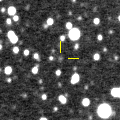
|
Now it is 16.7 mag (Apr. 18, ATLAS South Africa). It will brighten up to 13-14 mag from 2024 to 2025.
Date(TT) R.A. (2000) Decl. Delta r Elong. m1 Best Time(A, h)
Apr. 30 7 17.12 -25 57.3 8.136 8.043 81 17.1 20:17 ( 47, 11)
May 7 7 19.84 -25 31.7 8.172 8.006 77 17.1 20:25 ( 53, 6)
|

|
Now it is 16.4 mag (Apr. 15, ATLAS Chile). It stays observable at 16-17 mag in April. However, it will fade out rapidly, and it will be fainter than 18 mag in late May. It is observable in excellent condition in the Southern Hemisphere. It is not observable at all in the Northern Hemisphere.
Date(TT) R.A. (2000) Decl. Delta r Elong. m1 Best Time(A, h)
Apr. 30 5 10.79 -79 29.5 1.210 1.660 96 17.1 20:17 ( 13,-33)
May 7 6 3.45 -71 45.3 1.288 1.689 93 17.3 20:25 ( 21,-30)
|

|
Now it is 17.8 mag (Apr. 22, ATLAS Chile). It stays 17 mag for a long time from 2021 to 2022. In the Southern Hemisphere, it stays observable in good condition for a long time. It is not observable in the Northern Hemisphere.
Date(TT) R.A. (2000) Decl. Delta r Elong. m1 Best Time(A, h)
Apr. 30 6 40.42 -41 51.0 5.541 5.474 80 17.2 20:17 ( 42, -6)
May 7 6 41.42 -41 29.5 5.602 5.485 78 17.2 20:25 ( 46,-10)
|

|
It has not been observed yet in this apparition. appearing in the morning sky. It will brighten up to 15 mag in autumn, and it will be observable in good condition.
Date(TT) R.A. (2000) Decl. Delta r Elong. m1 Best Time(A, h)
Apr. 30 22 59.02 -4 46.2 2.930 2.497 55 17.4 3:37 (284, 11)
May 7 23 10.52 -3 42.7 2.836 2.472 58 17.3 3:28 (284, 13)
|
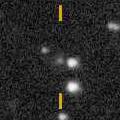
|
Now it is 17.5 mag (Apr. 25, ATLAS-MLO, Mauna Loa). It is expected to brighten up to 12.5 mag in winter. It will become unobservable temporarily at 17 mag in July. In the Northern Hemisphere, it will become observable again in October. Then it stays observable in good condition after that. In the Southern Hemisphere, it is not observable at the high light.
Date(TT) R.A. (2000) Decl. Delta r Elong. m1 Best Time(A, h)
Apr. 30 10 37.16 -0 33.8 3.254 3.874 121 17.4 20:17 ( 6, 54)
May 7 10 33.27 1 8.5 3.298 3.810 113 17.4 20:25 ( 23, 54)
|
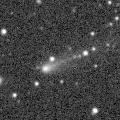
|
It brightened rapidly up to 14.5 mag in winter (Feb. 9, Toshiyuki Takahashi). Now it is fading rapidly. It has already faded down to 17.7 mag (Apr. 16, Y. Sugiyama). It will be fainter than 18 mag in May.
Date(TT) R.A. (2000) Decl. Delta r Elong. m1 Best Time(A, h)
Apr. 30 8 23.87 11 9.2 2.591 2.718 86 17.5 20:17 ( 63, 49)
May 7 8 31.57 10 41.2 2.696 2.735 81 17.6 20:25 ( 69, 44)
|
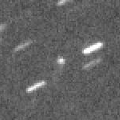
|
Now it is 17.7 mag (Apr. 30, D. Buczynski). It started fading before the perihelion passage. It was predicted to stay at 16 mag for a long time. But actually, it will be fainter than 18 mag in autumn. In the Northern Hemisphere, it stays observable in good condition for a long time. In the Southern Hemisphere, it is not observable until 2023.
Date(TT) R.A. (2000) Decl. Delta r Elong. m1 Best Time(A, h)
Apr. 30 0 19.59 76 34.5 4.084 3.756 64 17.5 3:37 (196, 33)
May 7 0 20.52 77 21.1 4.094 3.757 63 17.5 3:28 (195, 34)
|

|
It brightened up to 14.2 mag from summer to autumn in 2021 (Sept. 3, C. S. Morris). Now it is 17.3 mag (Apr. 13, Catalina Sky Survey). Fading slowly. In the Northern Hemisphere, it is observable in good condition. It is not observable in the Southern Hemisphere.
Date(TT) R.A. (2000) Decl. Delta r Elong. m1 Best Time(A, h)
Apr. 30 15 54.78 69 16.3 6.778 6.934 94 17.6 1:25 (180, 56)
May 7 15 39.36 69 41.7 6.842 6.973 93 17.6 0:42 (180, 55)
|

|
Now it is 17.6 mag (Apr. 21, ATLAS Chile). It will brighten up to 16 mag in 2023. In the Southern Hemisphere, it stays observable in good condition for a long time. In the Northern Hemisphere, it is observable only until May.
Date(TT) R.A. (2000) Decl. Delta r Elong. m1 Best Time(A, h)
Apr. 30 9 36.17 -16 24.3 3.748 4.202 110 17.6 20:17 ( 22, 36)
May 7 9 35.65 -16 26.6 3.799 4.163 104 17.6 20:25 ( 32, 32)
|

|
Now it is 17.8 mag (Apr. 28, W. Hasubick). It stayed 17.5 mag for a long time in 2021. It will be fading slowly after this. In the Northern Hemisphere, it is observable in good condition. It is not observable in the Southern Hemisphere.
Date(TT) R.A. (2000) Decl. Delta r Elong. m1 Best Time(A, h)
Apr. 30 11 42.90 67 58.9 7.131 7.240 92 17.6 21:10 (180, 57)
May 7 11 38.71 66 59.4 7.204 7.256 88 17.7 20:38 (180, 58)
|
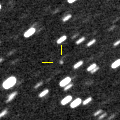
|
Now it is 17.1 mag (Apr. 17, ATLAS South Africa). It will brighten up to 15-16 mag in 2023. Cometary activity was detected by Cristovao Jacques on Dec. 12, and by Luca Buzzi and Andrea Aletti on Feb. 23.
Date(TT) R.A. (2000) Decl. Delta r Elong. m1 Best Time(A, h)
Apr. 30 6 16.82 -12 57.6 5.211 4.838 63 17.7 20:17 ( 67, 10)
May 7 6 16.99 -12 16.5 5.256 4.794 57 17.7 20:25 ( 73, 3)
|

|
Now it is 17.8 mag (Apr. 25, J.-G. Bosch). It is observable at 17 mag from spring to summer. In the Northern Hemisphere, it becomes low in summer.
Date(TT) R.A. (2000) Decl. Delta r Elong. m1 Best Time(A, h)
Apr. 30 11 12.28 29 16.0 1.531 2.166 115 17.9 20:39 ( 0, 84)
May 7 11 11.87 27 0.3 1.575 2.148 110 17.8 20:25 ( 20, 81)
|

|
Now it is 17.1 mag (Feb. 28, Hidetaka Sato). It was observed at 16 mag from 2020 to 2021. Now it is fading. It will be fainter than 18 mag in May.
Date(TT) R.A. (2000) Decl. Delta r Elong. m1 Best Time(A, h)
Apr. 30 14 25.76 -42 30.5 5.345 6.253 152 17.8 23:52 ( 0, 12)
May 7 14 16.23 -42 21.1 5.372 6.288 153 17.8 23:15 ( 0, 13)
|

|
It was observed at 16 mag from 2020 to 2021. Now it is fading. It will be fainter than 18 mag in summer.
Date(TT) R.A. (2000) Decl. Delta r Elong. m1 Best Time(A, h)
Apr. 30 22 25.93 15 22.5 7.115 6.640 58 17.8 3:37 (271, 29)
May 7 22 26.73 15 23.2 7.040 6.661 64 17.8 3:28 (274, 33)
|
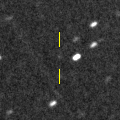
|
Now it is 17.9 mag (Apr. 17, W. Hasubick). It is expected to brighten up to 12-13 mag from 2024 to 2025.
Date(TT) R.A. (2000) Decl. Delta r Elong. m1 Best Time(A, h)
Apr. 30 9 57.43 -25 29.5 7.465 7.961 116 17.9 20:17 ( 13, 28)
May 7 9 55.55 -24 37.0 7.509 7.917 110 17.9 20:25 ( 23, 27)
|

|
Now it is 18.0 mag (Apr. 12, Ken-ichi Kadota). In the Northern Hemisphere, it stays observable for a long time while it is getting fainter slowly. It locates extremely low in the Southern Hemisphere.
Date(TT) R.A. (2000) Decl. Delta r Elong. m1 Best Time(A, h)
Apr. 30 14 7.61 47 11.0 7.739 8.260 118 17.9 23:33 (180, 78)
May 7 14 2.55 46 55.4 7.825 8.307 115 17.9 23:01 (180, 78)
|

|
Now it is 17.3 mag (Apr. 22, ATLAS Chile). Very far object. It stays 18 mag for a long time from 2021 to 2026. In the Southern Hemisphere, it stays observable in good condition for a long time. In the Northern Hemisphere, it is not observable at all.
Date(TT) R.A. (2000) Decl. Delta r Elong. m1 Best Time(A, h)
Apr. 30 7 26.82 -64 13.6 10.579 10.743 96 17.9 20:17 ( 21,-17)
May 7 7 26.86 -63 46.8 10.586 10.733 95 17.9 20:25 ( 24,-19)
|
|
![]()
 C/2017 K2 ( PanSTARRS )
C/2017 K2 ( PanSTARRS ) C/2021 F1 ( Lemmon-PanSTARRS )
C/2021 F1 ( Lemmon-PanSTARRS ) C/2019 L3 ( ATLAS )
C/2019 L3 ( ATLAS ) 22P/Kopff
22P/Kopff C/2021 E3 ( ZTF )
C/2021 E3 ( ZTF ) C/2019 T4 ( ATLAS )
C/2019 T4 ( ATLAS ) 19P/Borrelly
19P/Borrelly C/2021 P4 ( ATLAS )
C/2021 P4 ( ATLAS ) 9P/Tempel 1
9P/Tempel 1 C/2021 A1 ( Leonard )
C/2021 A1 ( Leonard ) C/2020 Y2 ( ATLAS )
C/2020 Y2 ( ATLAS ) C/2020 R7 ( ATLAS )
C/2020 R7 ( ATLAS ) 117P/Helin-Roman-Alu 1
117P/Helin-Roman-Alu 1 116P/Wild 4
116P/Wild 4 104P/Kowal 2
104P/Kowal 2 C/2020 V2 ( ZTF )
C/2020 V2 ( ZTF ) C/2019 U5 ( PanSTARRS )
C/2019 U5 ( PanSTARRS ) 29P/Schwassmann-Wachmann 1
29P/Schwassmann-Wachmann 1 C/2020 K1 ( PanSTARRS )
C/2020 K1 ( PanSTARRS ) (3200) Phaethon
(3200) Phaethon 73P/Schwassmann-Wachmann 3
73P/Schwassmann-Wachmann 3 C/2018 U1 ( Lemmon )
C/2018 U1 ( Lemmon ) C/2021 T2 ( Fuls )
C/2021 T2 ( Fuls ) C/2020 J1 ( SONEAR )
C/2020 J1 ( SONEAR ) C/2022 E3 ( ZTF )
C/2022 E3 ( ZTF ) 67P/Churyumov-Gerasimenko
67P/Churyumov-Gerasimenko C/2020 M5 ( ATLAS )
C/2020 M5 ( ATLAS ) C/2020 H6 ( ATLAS )
C/2020 H6 ( ATLAS ) C/2021 U5 ( Catalina )
C/2021 U5 ( Catalina ) 81P/Wild 2
81P/Wild 2 325P/Yang-Gao
325P/Yang-Gao 152P/Helin-Lawrence
152P/Helin-Lawrence C/2020 T2 ( Palomar )
C/2020 T2 ( Palomar ) C/2020 O2 ( Amaral )
C/2020 O2 ( Amaral ) C/2020 F5 ( MASTER )
C/2020 F5 ( MASTER ) 246P/NEAT
246P/NEAT C/2019 F1 ( ATLAS-Africano )
C/2019 F1 ( ATLAS-Africano ) 4P/Faye
4P/Faye 402P/2020 Q3 ( LINEAR )
402P/2020 Q3 ( LINEAR ) C/2020 F2 ( ATLAS )
C/2020 F2 ( ATLAS ) C/2020 PV6 ( PanSTARRS )
C/2020 PV6 ( PanSTARRS ) 70P/Kojima
70P/Kojima 99P/Kowal 1
99P/Kowal 1 C/2019 O3 ( Palomar )
C/2019 O3 ( Palomar ) C/2021 G2 ( ATLAS )
C/2021 G2 ( ATLAS ) C/2022 F2 ( NEOWISE )
C/2022 F2 ( NEOWISE ) C/2020 F7 ( Lemmon )
C/2020 F7 ( Lemmon ) 61P/Shajn-Schaldach
61P/Shajn-Schaldach C/2022 A2 ( PanSTARRS )
C/2022 A2 ( PanSTARRS ) 110P/Hartley 3
110P/Hartley 3 C/2020 U5 ( PanSTARRS )
C/2020 U5 ( PanSTARRS ) C/2019 K7 ( Smith )
C/2019 K7 ( Smith ) C/2021 C5 ( PanSTARRS )
C/2021 C5 ( PanSTARRS ) C/2020 P3 ( ATLAS )
C/2020 P3 ( ATLAS ) A/2021 X1
A/2021 X1 100P/Hartley 1
100P/Hartley 1 C/2017 Y2 ( PanSTARRS )
C/2017 Y2 ( PanSTARRS ) C/2019 T3 ( ATLAS )
C/2019 T3 ( ATLAS ) C/2022 E2 ( ATLAS )
C/2022 E2 ( ATLAS ) C/2018 N2 ( ASASSN )
C/2018 N2 ( ASASSN ) C/2019 E3 ( ATLAS )
C/2019 E3 ( ATLAS )![]()

























































